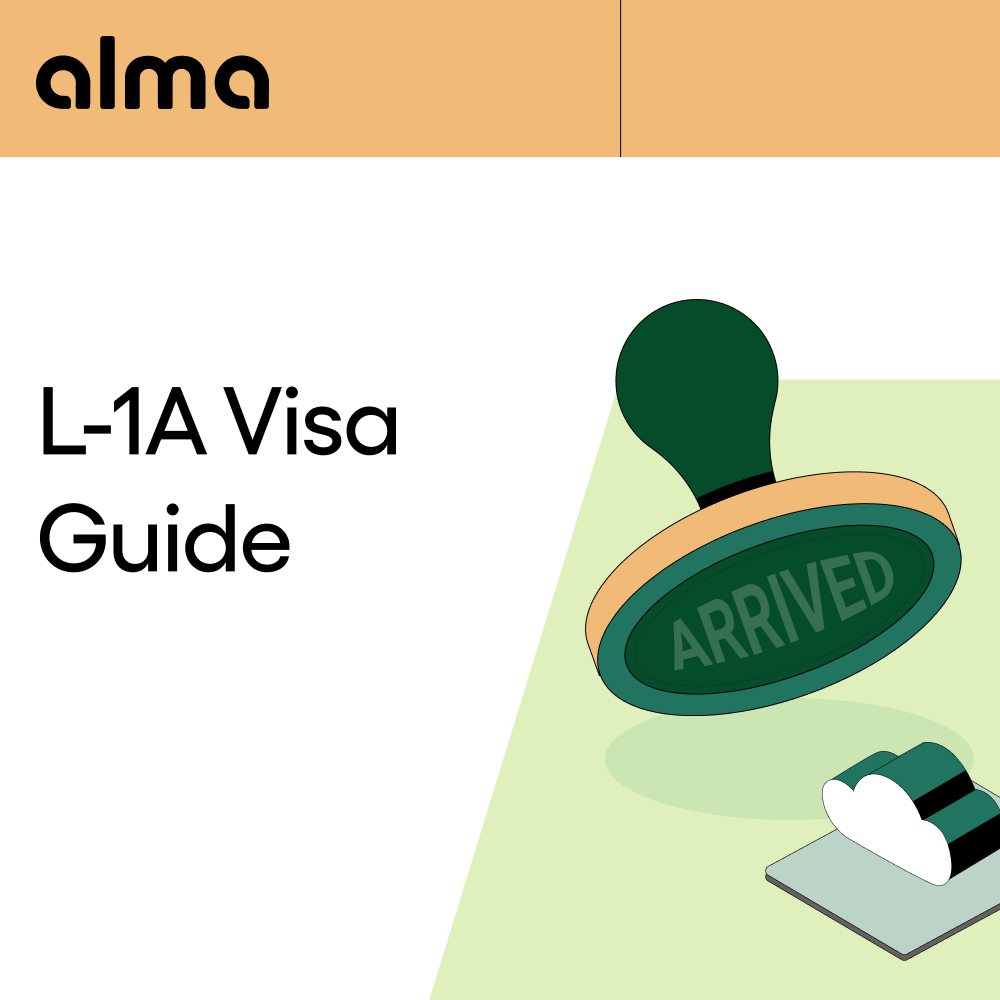- H-1B selection rates improved to 35.3% in FY 2026 – The beneficiary-centric system reduced fraud and created fairer lottery odds for legitimate applicants compared to previous years
- Employment-based approval rates vary dramatically by category – EB-1A approvals held at 60.65% while EB-2 NIW plummeted to 43.31%, making expert petition preparation critical for success
- Processing backlogs persist across most categories – Green card applications averaged 11 months by end of FY 2024, with some humanitarian visas exceeding six-year wait times
- Strategic category selection matters more than ever – With EB-1A petitions surging 56% and approval rates declining in competitive categories, working with experienced immigration attorneys maximizes success
- Technology-enabled legal services deliver superior outcomes – Alma's immigration platform combines 99%+ approval rates with 2-week document turnaround, addressing the speed and quality challenges revealed in these statistics
- Premium processing costs increased 12% in 2024 – Fees rose from $2,500 to $2,805, making budget planning essential for time-sensitive petitions
Critical data compiled from USCIS reports, Department of State records, and immigration law analysis to guide your petition strategy
H-1B Lottery and Selection Statistics
- 336,153 unique beneficiaries entered the FY 2026 H-1B lottery with a 35.3% selection rate. The new beneficiary-centric selection process resulted in 336,153 unique beneficiaries competing for available visa numbers. This 35.3% selection rate represents a significant improvement in transparency and fairness compared to previous registration-based systems. The improved odds mean qualified applicants working with experienced counsel have better chances of securing H-1B status on their first attempt.
- H-1B registrations dropped 26.9% from FY 2025 to FY 2026. USCIS data shows registrations fell 26.9% following implementation of the beneficiary-centric system. This dramatic decrease eliminated fraudulent multiple registrations that had inflated previous lottery numbers. Legitimate employers and foreign nationals now compete on a level playing field, making proper petition preparation through services like Alma's H-1B program essential for maximizing approval chances.
- FY 2024 H-1B registrations reached an all-time high of 758,994. The year before beneficiary-centric reforms, 758,994 eligible registrations were submitted, creating unprecedented competition. This record number reflected system manipulation through duplicate registrations. The subsequent reform demonstrates USCIS's commitment to fair lottery processes, benefiting applicants who work with compliant legal teams.
- Multiple registrations per beneficiary averaged just 1.01 in FY 2026 compared to 1.06 in FY 2025. The registration-per-beneficiary ratio dropped to 1.01 in FY 2026 from 1.06 the previous year. This near-perfect 1:1 ratio proves the new system effectively eliminated fraudulent multiple submissions. Companies using Alma's business immigration platform benefit from compliant filing strategies that align with USCIS integrity measures.
- H-1B denial rates peaked at 24% in FY 2018 before declining to 2-4% in recent years. Historical data reveals denial rates reached 24% in FY 2018 during periods of heightened scrutiny, then dropped to about 13% in FY 2020 and approximately 4% in FY 2021, remaining low (roughly 2-4%) in FY 2022-FY 2023. While denial rates were elevated during FY 2017-2018, working with legal teams maintaining high approval rates provides additional security for your petition.
Employment-Based Green Card Approval Statistics
- Employment-based green card approvals averaged 90% in FY 2024. Overall employment-based approval rates reached 90% across all categories in FY 2024. However, this aggregate figure masks significant variation between specific categories. Applicants need category-specific guidance to understand their actual approval probability and petition strategy.
- EB-1A extraordinary ability petitions achieved a 60.65% approval rate in FY 2024. Despite being considered a premium category, EB-1A approval rates stood at just 60.65% in FY 2024. This means nearly 40% of EB-1A petitions faced denial, representing substantial wasted time and investment. Alma's EB-1A services deliver 99%+ approval rates by leveraging expert attorneys who understand evolving USCIS adjudication standards and build comprehensive evidence packages that exceed regulatory thresholds.
- EB-2 National Interest Waiver approval rates plummeted to 43.31% in FY 2024. The most dramatic decline occurred in the EB-2 NIW category, where approval rates fell to just 43.31% from 79.99% the previous year. This represents a staggering 46% decrease in approval rates year-over-year. Such volatility underscores the critical importance of working with immigration attorneys who track adjudication trends and adapt petition strategies accordingly. Alma's EB-2 NIW services at $10,000 include comprehensive legal analysis that addresses the heightened scrutiny driving these declining approval rates.
- EB-1A petitions surged 56% in Q1 FY 2025 to 7,338 cases. Filing volume increased 56% to 7,338 petitions in the first quarter of FY 2025. This surge reflects applicants seeking alternatives to backlogged EB-2 categories. However, increased volume combined with lower approval rates creates a more competitive environment where petition quality determines outcomes. Superior legal preparation becomes the differentiating factor for approval.
Processing Times and Backlogs
- Green card processing times averaged 11 months by the end of FY 2024. USCIS data shows average processing reached 11 months for green card applications by fiscal year-end. These extended timelines create uncertainty for applicants maintaining temporary status. Alma's platform provides real-time case tracking with automated alerts on processing milestones, ensuring applicants stay informed throughout lengthy adjudication periods.
- Employment-based approvals peaked at 36,211 in Q3 FY 2024 despite fewer new applications. Processing data reveals 36,211 employment-based approvals occurred in Q3 even as new filings decreased. This pattern suggests USCIS focused on clearing backlogs rather than processing fresh cases. Understanding these processing patterns helps attorneys time petition filings strategically to avoid adding to queue backlogs.
- U visa median wait times exceed six years according to USCIS estimates. Humanitarian visa backlogs remain severe, with U visa wait times exceeding six years. These extraordinary delays demonstrate systematic processing capacity challenges across USCIS. While Alma focuses on employment-based immigration, these statistics illustrate the broader agency-wide resource constraints affecting all petition categories.
- Premium processing fees increased from $2,500 to $2,805 in February 2024. USCIS raised premium processing fees to $2,805 from $2,500 for most I-129 petitions. This fee increase adds to overall petition costs while guaranteeing 15-day processing. For time-sensitive cases, premium processing remains worthwhile, but applicants must budget for these higher fees. Alma's transparent pricing includes all administrative charges upfront, eliminating surprise costs.
Family-Based Immigration Statistics
- Family-based adjustment of status applications increased 7% to 129,000 in Q1 FY 2025. Filing volume grew 7% to 129,000 applications in the first quarter. This steady increase reflects sustained demand for family-based immigration pathways. While Alma specializes in employment-based visas, these statistics demonstrate the broader immigration landscape affecting USCIS processing capacity.
- Form I-751 condition removal filings doubled to nearly 30,000 in Q1 FY 2025. Conditional residence removal petitions doubled to nearly 30,000 cases compared to previous quarters. This surge creates additional processing delays across USCIS service centers. The dramatic increase illustrates how petition volume fluctuations impact overall processing times for all case types.
- K-1 fiancé visa petitions reached 11,609 in Q1 FY 2025. Fiancé visa filings totaled 11,609 petitions in the first quarter, continuing elevated post-pandemic levels. These sustained high volumes demonstrate ongoing demand for family-based immigration options. The consistent filing rates suggest processing backlogs will persist without additional USCIS resources.
Humanitarian Visa Trends
- Asylum applications remained near 100,000 in Q1 FY 2025. Asylum filings approached 100,000 cases in the first quarter of FY 2025. These unprecedented volumes strain USCIS adjudication capacity across all immigration categories. While Alma focuses on skilled worker visas, understanding agency-wide workload helps set realistic processing expectations.
- T visa applications hit 15,332 in FY 2024 but only 3,786 were approved. Trafficking victim visas saw 15,332 applications with just 3,786 approvals in FY 2024. This 24.7% approval rate reflects both high application volume and rigorous evidentiary standards. The wide gap between applications and approvals demonstrates the importance of comprehensive petition preparation even in humanitarian categories.
- Congress caps T visa approvals at 5,000 per year, though applications consistently exceed this number. Congress caps principal T-1 approvals at 5,000 per fiscal year. Historically, applications have exceeded this cap while USCIS has not reached the 5,000 approval limit. The growing number of applications indicates increasing awareness of trafficking victim protections, though high application volumes contribute to processing backlogs.
Why These Statistics Matter for Your Immigration Strategy
These 19 statistics reveal three critical trends affecting immigration petition success in 2025:
Declining approval rates in competitive categories demand superior legal preparation. With EB-2 NIW approvals dropping below 50% and EB-1A petitions facing 40% denial rates, generic petition strategies no longer suffice. Applicants need attorneys who understand current adjudication standards and build evidence packages that exceed evolving USCIS expectations.
Processing delays create extended uncertainty periods. Average processing times approaching one year mean applicants must maintain valid status throughout lengthy adjudication periods. Platform-based immigration services with automated compliance tracking prevent status violations during extended waits.
System reforms benefit applicants working with compliant legal teams. The beneficiary-centric H-1B system rewards proper filing practices while eliminating fraudulent strategies. Companies and individuals working with experienced immigration counsel gain competitive advantages in reformed systems.
Alma addresses these challenges through a combination of legal expertise and technology. Our attorney-led platform delivers 99%+ approval rates while maintaining two-week document turnaround times. Real-time case tracking provides visibility throughout processing periods, while our compliance dashboard ensures you maintain lawful status during extended adjudications.
For businesses managing multiple petitions, Alma's enterprise immigration platform provides centralized tracking across all cases, automated compliance alerts, and approval trend analytics that inform strategic workforce planning. This data-driven approach transforms raw immigration statistics into actionable insights for your organization.
Frequently Asked Questions
The FY 2026 H-1B lottery achieved a 35.3% selection rate for unique beneficiaries under the new beneficiary-centric system. This represents improved odds compared to previous years when fraudulent multiple registrations diluted selection probabilities. The 26.9% decrease in total registrations created a fairer lottery environment where legitimate applicants have better chances.
Overall employment-based approvals averaged 90% in FY 2024, but this aggregate masks significant category variation. EB-1A petitions achieved 60.65% approval while EB-2 NIW dropped to just 43.31%. These statistics emphasize the importance of category-specific expertise. Alma's green card services deliver 99%+ approval rates by selecting appropriate categories and building comprehensive evidence packages.
Green card processing averaged 11 months by the end of FY 2024, though actual times vary significantly by service center and petition category. Some humanitarian categories like U visas experience wait times exceeding six years. Working with Alma provides real-time processing updates through our case tracking platform, ensuring you stay informed throughout the adjudication period.
EB-2 NIW approval rates plummeted to 43.31% from nearly 80% the previous year, representing a 46% decrease. This decline likely reflects stricter adjudication standards and increased scrutiny of national interest claims. The dramatic shift emphasizes why working with attorneys who track approval trends is essential. Alma's legal team adapts petition strategies based on current adjudication patterns, maintaining our 99%+ approval rate even as national averages decline.
Premium processing fees increased from $2,500 to $2,805 in February 2024. Whether this investment makes sense depends on your timeline urgency. For time-sensitive cases where standard processing averages 11 months, premium processing's 15-day guarantee often justifies the additional cost. Alma's transparent fee structure includes all administrative costs upfront, and our two-week document preparation turnaround maximizes the value of premium processing by eliminating preparation delays.



.png)

.png)


